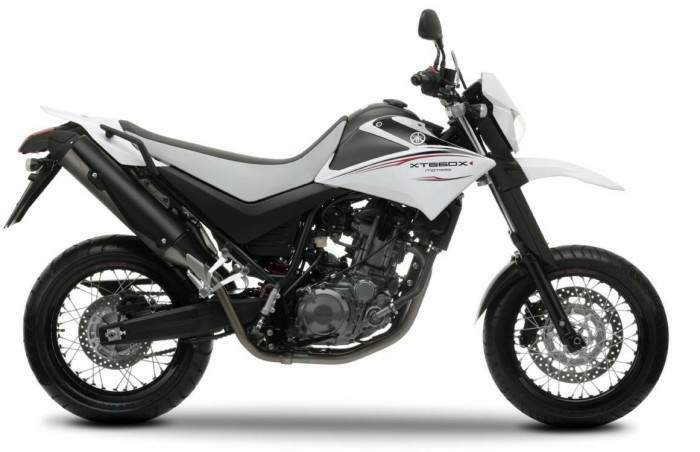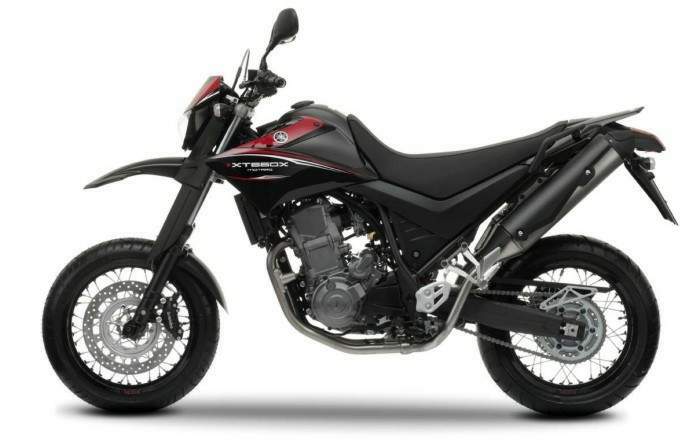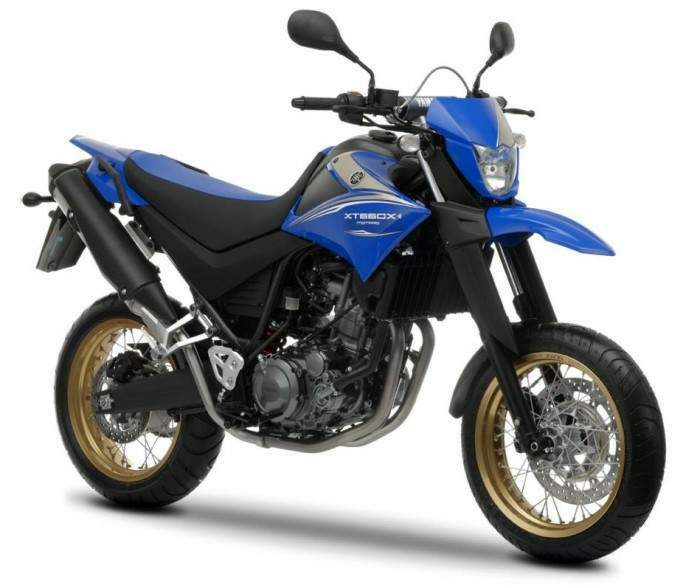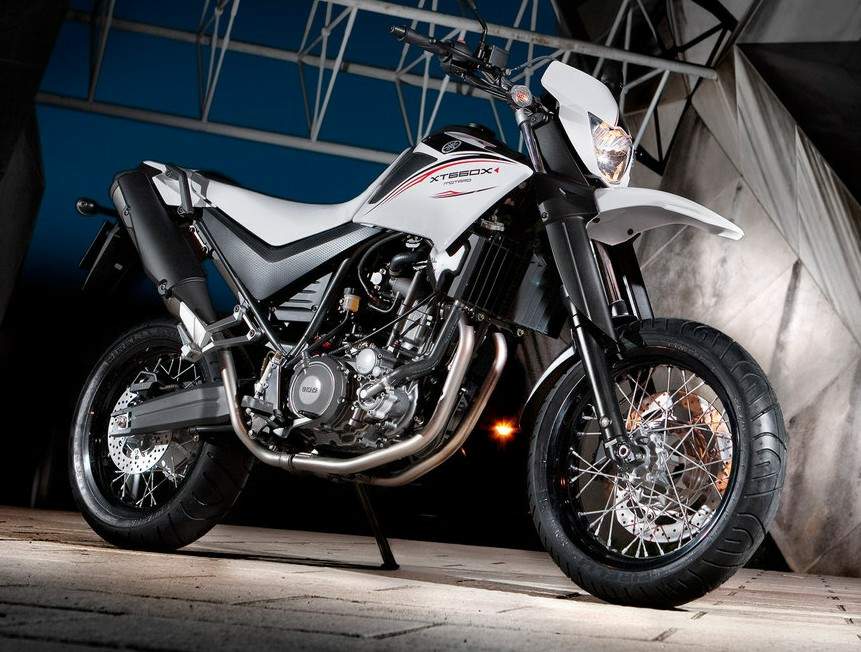| . |
|
Make Model |
Yamaha XT 660X |
|
Year |
2009 |
|
Engine |
Four stroke, single cylinder, SOHC, 4 valve |
|
Capacity |
659 cc/ 40.2 cu-in |
| Bore x Stroke | 100 x 84 mm |
| Compression Ratio | 10: 1 |
| Cooling System | Liquid cooled |
|
Induction |
Fuel injection, 44 mm throttle body |
| Lubrication | Dry sump |
| Oil Capacity | 2.9 Litres / 0.19 quarts |
|
Ignition |
TCI |
| Starting | Electric |
|
Max Power |
33.8 kW / 48 hp @ 6000 rpm |
|
Max Torque |
58.4 Nm / 5.7 kgf-m @ 5250 rpm |
| Clutch | Wet, multiple-disc coil spring |
|
Transmission |
5 Speed |
| Final Drive | Chain |
| Frame | Steel tubular diamond frame with dual tank rails |
|
Front Suspension |
43 mm Telescopic forks, |
| Front Wheel Travel | 225 mm / 8.8 in |
|
Rear Suspension |
Oscillating arm standard Monocross. |
| Rear Wheel Travel | 200 mm / 7.9 in |
|
Front Brakes |
Single 320mm disc 4 piston caliper |
|
Rear Brakes |
Single 245mm disc 1 piston caliper |
|
Front Tyre |
120/700-17 |
|
Rear Tyre |
160/60-17 |
| Rake | 26.0° |
| Trail | 94 mm / 3.7 in |
| Dimensions |
Height 1170 mm / 461 in Length 2175 mm / 85.6 in Width: 860 mm / 33.9 in |
| Wheelbase | 1505 mm / 59.3 in |
| Ground Clearance | 210 mm / 8.3 in |
| Seat Height | 875mm / 34.4 in |
|
Dry Weight |
173 kg / 318.4 lbs |
| Wet Weight | 186 kg / 410.1 lbs |
|
Fuel Capacity |
15 Litres / 3.9 gal |
| . |
Yamaha's XT660 is the latest of a
series stretching back to the XT500 of 1976 (1975, if you live
in the US) and, like the Virginia Slims lady, it's come a long
way.
The XT660 comes in two flavours: the XT660R is a conventional
dual-purpose bike with narrow trials universal tyres on large
wheels while the XT660X is a genuine street-legal supermotard
with chunky 17" Pirelli superbike tyres on Excel alloy rims and
a muscular four-pot Brembo calliper on a 320mm disc for
race-track standard braking – accompanied, as on all
supermotards, by extravagant front-end dive.
The old Yammie singles had a fearsome - and well-deserved -
reputation for kicking back when you tried to start them (one
broke one of my feet on Christmas Eve 1999) but the 660 is a
whole new motor with two camshafts, four valves, electronic fuel
injection and (hallelujah!) an electric foot
The 660 is a whole new motor with dual camshafts, four valves, fuel injection and an electric foot
It's a free-revving, smooth-spinning, surprisingly compact,
watercooled engine with balance shafts inside to reduce
vibration and a very un-Yamahalike rat's nest of cables, pipes
and oil lines on the outside.
The bikes are built by MBK in France and the industry grapevine
has it the engines come from Italian single-cylinder specialist
Minarelli. I was unable to confirm this, but it does look very
Italian.
The fuel injection system, however, is pure Japanese and made by
Mikuni. It breathes through a 44mm throttle body and provides
very rapid throttle response, with a secondary valve operated by
inlet vacuum to smooth out the slamming-door effect of suddenly
closing the throttle to which all such bike set-ups are prone

The bike went up to 155km/h very quickly, but topped out at a disappointing 162
Even at low speed in traffic, it works; engine revs are easy to
modulate and the stonking mid-range provides punchy acceleration
for grabbing the gaps, making the XT660X a superb city bike.
There's quite a strong feeling, however, that the bike is
breathless at the top end but without a rev-counter it's very
difficult to quantify, so we have to go back to the numbers.
Yamaha claims 35.3kW at 6000rpm, about on par with BMW's F650
GS, the benchmark for the class, along with peak torque of
58.4Nm at a highish (for a single) 5250, although at 173kg its
four kilograms lighter than the Spandau single.
The bike went up to 155km/h very quickly but topped out at a
disappointing 162 – and I had to work for that. I suspect that
the XT has been geared short for sparkling acceleration and that
it was way past its power peak at full taps.
The only way to prove it would be to change one or both
sprockets – it's likely you'd get appreciably longer legs at the
expense of a little mid-range.

Of you could shift the power peak upwards by replacing the woosy-sounding
standard pipes with something a little less restrictive; the
fuel injection would compensate for the higher gas velocities
and you should get mid-range and top end - plus a whole
lot more noise.
As issued, the bike is commendably quick through the gears and
quiet enough to satisfy the Noise Police – but not very fast.
It drives through a nicely modulated clutch and a slick
five-speed gearbox with a long lever throw. The bike didn't miss
a shift, with or without the clutch, throughout the test
although I wasn't always sure that the cogs had engaged.
It didn't bother me but it was the one feature of the bike that
my wife didn't like; "vague" was her word for it.
Conventional frame
The frame is a very ordinary, open-cradle diamond made of round
steel tubing with a welded-on sub-frame of the same stuff and a
heavy-duty, rectangular-section steel swing-arm. It looks like
something out of the 1970s but workswell.
The suspension is quality stuff: 43mm conventional forks by
Paioli – complete with a built-in, laser-cut fork brace looking
after the front wheel and monocross linkage ensuring rising-rate
movement at the back.
Each end is supple, without discernable stiction, soaking up the
worst that our poorly-maintained roads can throw at them without
the bike getting out of shape - and don't forget, this is
essentially an off-road set-up.
Hard braking has it diving like a gannet after a fish,
quickening the already steep steering-head angle and to some
extent compromising the bike's stability.
The back end gets very light indeed; the slightest prod on the
rear brake will have it hopping and sliding – and suddenly you
understand how supermotards work.
Hard cornering
The bike isn't built for stability – if you want that, get a
Ducati – it's built to hammer up to a corner, slide the rear
wheel round to help it turn in faster than you'll believe
possible until you've done it and punch away from walking pace
with its front wheel in the air.
It won't reward a tentative approach; you have to throw your
heart – and your inside shoulder – into every corner like it was
the last before the flat. Then it comes into its own, changing
direction with dizzying suddenness.

With this bike even an old-school rider such as me can dive
under supposedly much quicker machinery going into tight corners
- the Grin Factor, let me assure you, is huge.
Superb brakes
You need superlative brakes to get away with such riding so the
XT660X has a class-leading Brembo four-pot calliper clamping a
320mm platter through braided stainless-steel hose - straight
out of the box.
A wise choice of master cylinder specifications gives it superb
bite, feel and feedback and enough power to pull spectacular
stoppies. This is one of the best front brakes I've used and is
responsible for the bike's agility under pressure.
Getting very naughty indeed is both easy and fun on the XT; even
the rear brake, a supposedly ordinary single-pot Brembo, has
more feel than any rear other I've tried so makes those lurid
slides eminently surviveable.
All motorcycle handling is essentially a compromise; the other
side of the XT660X coin is that the bike has a tendency to shake
its head above 140km/h no matter how gently you hold the bars.
The top-end runs were done with my left hand holding the fork
stanchion below the lower triple clamp and just two fingers
holding the twistgrip – and even then I felt a slight shimmy
through the frame.
Aggessive styling
But that's not what it's for; the bike is in its element as an
inner-city hooligan tool – and it certainly looks the part.
Start with an abbreviated flyscreen, bare-bones digital
intrumentation, shrouded forks and a two-piece front mudguard.
OK, the bike loses street cred because the headlight is big
enough to actually work but let's forgive the occasional lapse
into practicality.
The hump-backed, 15-litre motocross fuel tank is emphasised by
faired-in side panels down to the radiator and at 5.8
liters
/100km will take you at least 240km. The two-tone seat is
wide and flat so you can transfer your weight quickly to where
it'll do the most good.
There's a separate pipe for each exhaust port, sweeping
dramatically up under the knife-edged tailpiece into two neat,
though rather large, mufflers with a neatly curved little tail
light between them.
The wide, off-road style handlebars end in neat, French-styled,
switchgear and a pair of chic oval mirrors that give you the
unfortunately obligatory clear view of your elbows.
The bike is rudely and aggressively styled; that's to be
expected since it comes from France, the home of the
supermotard. It looks like exactly what it is, an enduro bike on
street wheels, but its relaxed seating position is surprisingly
comfortable and it's eminently rideable thanks to its
uncomplicated power delivery, agile handling and magnificent
brakes.
It's a little twitchy in a straight line but it's not as raw a
ride as it looks; it's a motocross-based tarmac terrorist
cleaned up for the street as only the French could do it.
Source motoring.co.za

